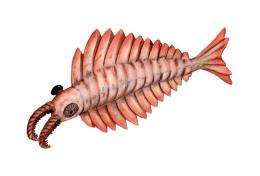Anomalocaris canadensis, the top predator from the middle Cambrian Burgess Shale of British Columbia, pencil drawing, digital coloring. The "tail fins" in this reconstruction should be placed ventrally (on top of the organism), and not at the rear as illustrated. Image: Nobu Tamura, via Wikipedia.
(PhysOrg.com) -- A Cambrian sea creature, Anomalocaris Canadensis, had long been thought to be a fearsome predator of trilobites, equipped as it was with barbed feelers and an armor-plated mouth, but new research suggests it was incapable of eating adult trilobites and probably survived by dining on "mush."
Anomalocaris was a meter-long shrimp-like creature with lobed wings that lived around 500 million years ago. It is often illustrated in the act of devouring trilobites or other shelled animals, and has been dubbed the first “super predator” because of its supposed ability to swoop down and attack trilobites on the sea bed.
Researchers from the Denver Museum of Nature and Science, led by paleontologist James “Whitey” Hagadorn, reconstructed the mouth parts of Anomalocaris by examining 400 fossils and selecting the best specimens and feeding their data into a 3D computer model. They also reconstructed 12 groups of trilobites of various kinds, modeling their shell strength on modern day lobster and crab shells. Hagadorn said the group tried to model the full range of shapes and sizes of prey and predator mouth parts.
The computer model enabled them to test how much force the animal could generate with its bite. The results showed Anomalocaris’ armored mouth parts would break before adult trilobite shells did, the feelers were inflexible, and their mouths could not fully close. The fossils also suggested the teeth were actually flexible protrusions and the mouth parts were able to fold, which would not have been possible if their mouth parts were hard.
Hagadorn said there was also no positive evidence of trilobite or other crushed shells within fossil feces or gut contents, and no evidence of the broken or chipped mouth parts that would be expected in a shell-crunching predator. The findings of the research suggest it was extremely unlikely Anomalocaris could have eaten most trilobites.
Trilobite fossils have been found that appear to have scars or bite marks resembling Anomalocaris’ bite, but Hagadorn suggested the creatures possibly “ingested things and then spit them out,” but did not eat the trilobites.
Hagadorn said the most likely diet of Anomalocaris was similar to that of modern arthropods such as crabs, lobsters and shrimps, which mostly eat soft items such as worms in the mud or microorganisms or plankton in the water. It could have eaten very small trilobites and recently molted trilobites whose new shells had not yet hardened, but the vast majority of trilobites would have broken Anomalocaris’ mouth parts.
He stressed there is no positive evidence of Anomalocaris’ diet, but said this is not surprising because in the fossil record “mushed-up” worms, phytoplankton or snails are “all going to look like mush.”
The results of the research were presented on 1 November at the annual meeting of the Geological Society of America in Denver, Colorado.
© 2010 PhysOrg.com





















